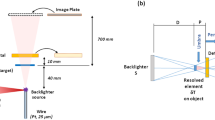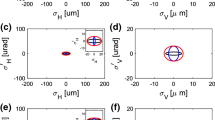Abstract
Monochromatic X-ray backlighting has been employed with great success in various laser plasma experiments including inertial confinement fusion (ICF) research. However, implementation of a monochromatic backlighting system typically requires extremely high quality spherically bent crystals which are difficult to manufacture and are also expensive. In this paper, we present a quasimonochromatic X-ray backlighting system using flat thallium acid pthalate (TAP) crystal. The detailed characterization of the system is discussed. The X-ray backlighter spectral range is caliberated using Cu spectrum in the spectral range 7–9 Å (1.38–1.77 keV). Gold plasma produces continuous X-ray spectrum (M band) in this range. The spectral, spatial and temporal resolutions of the system measured are 30 mÅ, 50 μm and 1.5 ns respectively. The spectral width of the X-ray pulse is 2 Å (ΔE = 0.39 keV).





Similar content being viewed by others
References
J D Kilkenny, Phys. Fluids B 2, 1400 (1990)
B A Remington, S W Haan, S G Glendinning, J D Kilkenny, D H Munro and R J Wallace, Phys. Rev. Lett. 67, 3259 (1991)
S G Glendinning et al, Rev. Sci. Instrum. 70, 536 (1999)
S G Glendinning et al, Phys. Rev. Lett. 80, 1904 (1998)
B Yaakobi, D Shvarts, R Epstein and Q Su, Laser Part. Beams 14, 81 (1996)
V A Smalyuk et al, Phys. Rev. Lett. 81, 5342 (1998)
J Balmer et al, Phys. Rev. A 40, 330 (1989)
C Chenais-Popovics et al, Phys. Rev. A 40, 3194 (1989)
J Bruneau et al, Phys. Rev. Lett. 65, 1435 (1990)
A Ravasio et al, Phys. Plasmas 15, 060701 (2008)
L B Da Silva, P Celliers, G W Collins, K S Budil, N C Holmes, T W Barbee Jr, B A Hammel, J D Kilkenny, R J Wallace, M Ross, R Cauble, A Ng and G Chiu, Phys. Rev. Lett. 78, 483 (1997)
S A Pikuz, T A Shelkovenko, V M Romanova, D A Hammer, A Y Faenov, V A Dyakin, and T A Pikuz, Rev. Sci. Instrum. 68, 740 (1997)
D B Sinars et al, Rev. Sci. Instrum. 74, 2202 (2003)
D B Sinars, G R Bennett, D F Wenger, M E Cuneo, D L Hanson, J L Porter, R G Adams, P K Rambo, D C Rovang and I C Smith, Rev. Sci. Instrum. 75, 3672 (2004)
H Azechi, S Oda, M Hamano, T Sasaki, T Yamanaka and C Yamanaka, Appl. Phys. Lett. 37, 998 (1980)
C L S Lewis and J McGlinchey, Opt. Commun. 53, 179 (1985)
M H Key et al, Phys. Rev. Lett. 41, 1467 (1978)
J Launspach et al, Nucl. Fusion 21, 100 (1981)
M H Key et al, Phys. Rev. Lett. 45, 1801 (1980)
M H Key et al, Opt. Commun. 44, 343 (1983)
S Chaurasia et al, BARC/2008/E/019, pp. 32–34 (2008) and references therein
V A Boiko, A V Vinogradov, S A Pikuz, I Yu Skoblev and A Ya Faenov, J. Sov. Laser Res. 6, 85 (1985)
A Rossel, L M R Gartside, S Chaurasia, S Tripathi, D S Munda, N K Gupta, L J Dhareshwar, J Gaffney, S J Rose and G J Tallents, J. Phys. B: At. Mol. Opt. Phys. 43, 155403 (2010)
S Chaurasia, M Kumar, A K Poswal, D S Munda, L J Dhareshwar, R K Kher and G Chourasiya, Nucl. Instrum. Methods in Phys. Res. A 595, 395 (2008)
S Chaurasia, S Tripathi, P Leshma, C G Murali and J Pasley, Opt. Commun. 308, 169 (2013)
Acknowledgements
The authors wish to acknowledge the support and continuous encouragement received from Dr. S Kailas, Director, Physics Group, BARC. Authors wish to thank Dr S M Sharma, Head, HP&SRD for his valuable time for the technical discussion during the preparation of the manuscript. Authors also wish to acknowledge excellent support provided by Shri C G Murali and Mr Ritesh Sable for the smooth laser operation.
Author information
Authors and Affiliations
Corresponding author
Rights and permissions
About this article
Cite this article
CHAURASIA, S., LESHMA, P. & MUNDA, D.S. Development of online quasimonochromatic X-ray backlighter for high energy density physics studies. Pramana - J Phys 81, 829–838 (2013). https://doi.org/10.1007/s12043-013-0616-2
Received:
Revised:
Accepted:
Published:
Issue Date:
DOI: https://doi.org/10.1007/s12043-013-0616-2




